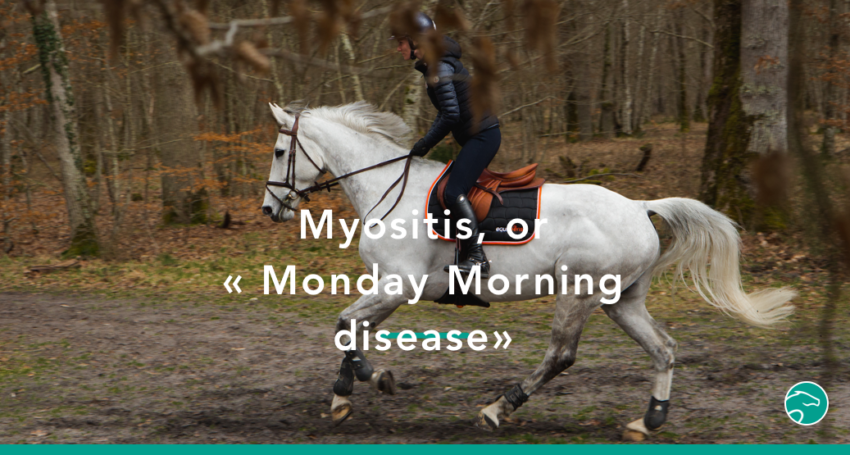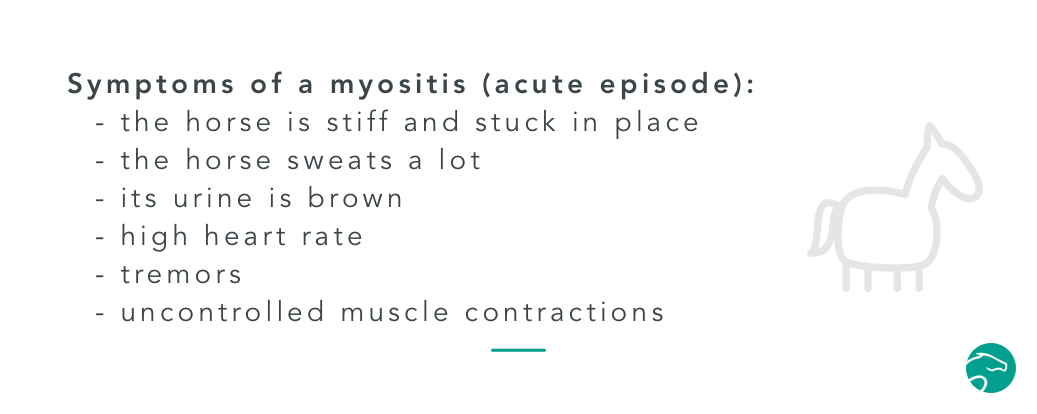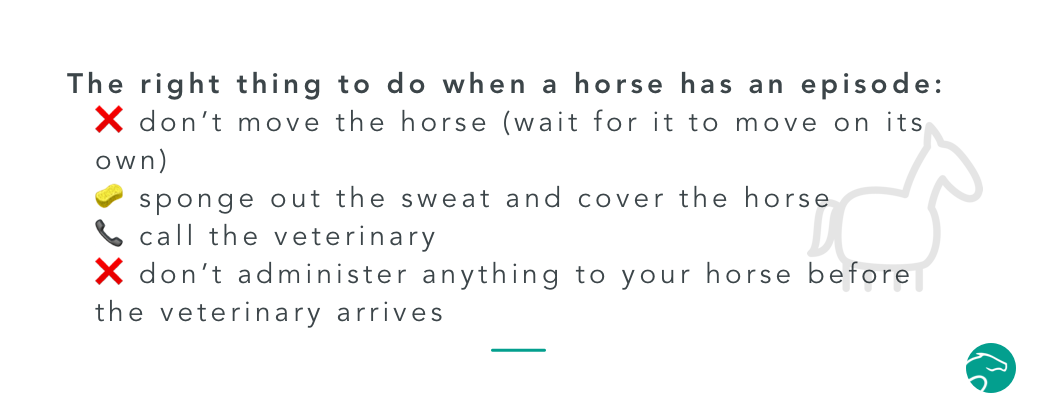
The Horse’s Myositis: What can I do?
Myositis is a muscle disorder (a myopathy) often linked to effort. It can be really overwhelming and every horse owner should know about it. Indeed, dealing with it is important to get your horse back to work after the episode and lessen the horse’s pain. Let’s have an overview of the horse’s myositis.
As an anecdote, my mare O la belle has been prone to recurring myositis her entire life. This gave my a long experience of myositis episodes and how to handle them during our daily life. And trust me, it’s not really fun. 😫
Table des matières
🧐 What is myositis in the horse?
It’s actually a pathology we know under a lot of different names: Myositis, Rhabdomyolysis, Monday Morning disease, RER, EPSM, Tying up…
This disease is similar to generalized and very painful cramps for the horse. It corresponds to a destruction of the striated skeletal muscle cells, so a necrosis (yum). The word Rhabdomyolysis is actually pretty self explanatory: Rhabdo = striated / Myo = muscle / Lysis = destruction.
(What do you mean you didn’t know what “rhabdo” meant?? 😉)

It can appear occasionally, or on a recurring basis. I’ll explain the difference in a bit.
🤔 How do we recognize a myositis in the horse?
Firstly, myositis happens when the horse does an effort, especially intense efforts, too intense for the horse. It is also called Monday Morning disease because it can happen when the horse starts working again after a period of rest (like spending the whole sunday in the stall).
In case of an acute episode, the horse will be stuck in place because of the pain and be completely stiff. It is unable to move. If the horse is laying down, it can’t get back again. 😨
Often the horse will sweat a lot (impressively so). 💦 It can also have a high heart rate, tremors, uncontrolled muscle contractions and its urine will be colored brown or black. 😮 That’s because when the muscle is destroyed, it releases myoglobine (the molecule storing the oxygen in the muscle) in urine. This can induce a kidney failure (which can kill the horse – not cool 😱).
For lighter episodes, you can notice a lameness on the hind legs when the horse’s legs are hot, a widespread muscle stiffness (the horse looks sore), and a pain around the hind legs and the back. The horse clearly isn’t fit to work. In more technical terms, we say it is underperforming.
💉 In any case, a simple blood test will confirm the diagnostic. We’re testing the Creatine Kinase levels (CK). Creatine Kinase are enzymes, released when the muscle is destroyed. It will allow you to see the extent of the damage.

⏩ Learn more: 4 dressage exercises to build your horse’s muscles
⁉️ What causes the horse’s myositis?
The factors are different depending on the type of myositis.
➡️ Occasional / sporadic myositis
If the myositis is occasional, it’s actually an “incident” connected to an exercise unsuited to the horse’s physical condition. As I was saying earlier, this often happens when the horse starts working again after it stopped for a while or if you do a session too intense for an unprepared horse. An intense session can also mean you’re going too fast: like a too quick warm up before you jump.
🔁 For recurring myositis
If the myositis is recurring, it’s actually linked to a genetic predisposition. There are two main types:
👉 The RER
The RER is actually the Recurrent Exertional Rhabdomyolysis. It is caused by bad calcium management in the muscle cell.
RER mostly affects mares, thoroughbreds, arabian horses and trotters. Unlike the other forms of the disease, the episodes can be triggered by stress or excitation at work, without necessary pushing the horse too far, or changing its environment or routine.
There are predisposed bloodlines, so we tend to think it’s genetic, but the truth is the gene responsible for this still hasn’t been found.
👉 The EPSM
The EPSM, the Equine polysaccharide storage myopathy, is a genetic disease causing a problem in energy storage inside the muscle cell. Instead of being stored as glycogen (the normal form of the muscle “fuel”), the energy is stored as big polysaccharides the cell can’t use.
It affects mostly draft horses, Quarter Horses, or even Selle Français.
💡 There are 2 types of EPSM (type I and type II). You can do a genetic test, based on a mane sample to know if your horse has type I EPSM. You can talk about it with your veterinary.
😳 What should I do if my horse has a Myositis episode?
When faced with an acute episode, it’s important to call your veterinary. 📲 As I was saying earlier, the horse risks a kidney failure because of all these toxins released at the same time.
⚠️ Then, despite what we might think, you shouldn’t walk your horse, nor should you shower it (unless the weather is really hotter than usual). It’s better to let it rest without moving (not the best when this happens outside of the arena, but no choice – this happened to me twice 😓), unless the horse moves on its own, and to cover it. The goal is to help with the pain, and often the warmth helps.
You can also massage the painful spots.
Once they get there, the veterinary will look at the horse and do a blood test to confirm the diagnostic. They can also install a drip if the horse is too dehydrated, and give your horse painkillers.
The veterinary can even administer tranquilizer to induce a muscle release.
⚠️ Don’t do this on your own. Depending on the dehydration levels of the horse, the treatment can do more harm than good.

🧐 What is the correct treatment and how to get my horse back at work after a myositis?
If the myositis is occasional, the first and most important treatment is rest. The horse should rest until it gets back to its usual muscle settings. A blood test should be programmed a week or two after the incident to make sure all is well.
Depending on the severity of the episode, rest can go from a few days to a few weeks.
Oftentimes, the veterinary will advise you to walk your horse to avoid complete rest which could lead to another myositis. Because yes, it’s possible to do another myositis when getting back to work post-myositis. 😓 That’s what makes this pathology so complicated.
For horses affected with recurring episodes, getting back to work is essential. Indeed, the changes in the routine are what made the episode happen in the first place. It’s then important to go back to this routine, so important to the horse. Of course, the workload is adjusted to the severity of the episode. Once again, the veterinary will help you handle your horse getting back to work.
📚 Learn more: Help! My horse has tendinitis
❌ How to avoid myositis?
That’s the challenge: being safe rather than being sorry.
1️⃣ Plan your sessions
For occasional myositis, the only thing you can do to prevent it is to handle the workload with great care. It’s important to gradually bring the horse to the needed intensity level, and not ask this intensity right off the bat. Planning your training ahead will help you approach this gradual intensity increase peacefully. During every session, take some breaks, warm up your horse gradually, and think about active recovery. This will help you take less risks.
⏩ Important: Plan your horse’s training
If you’re getting back to work after a break, it’s even more important to plan this very gradually.
Also let’s not forget horses are made to live outside, and it is highly recommended to avoid making them spend complete days in their stalls.
It’s better for the horses to live in a calm environment, with daily turnouts at fixed times to avoid any stress linked to routine changes. 🧘♀️
⏩ Read more: How to find the right stables?
2️⃣ Plan the meals 🥕
For recurrent myositis, there is a bit more you can do. Indeed as I explained earlier, EPSM is a disease linked to a bad energy absorption and one of the key things you can do is keep a close eye on what the horse eats. For these horses, it’s better to choose a starch light feed.
Decreasing the starch levels will bring less glucose into the blood and thus keep the muscle cells from storing this glucose as polysaccharides which are what creates episodes for horses with EPSM.
A feed with high starch levels will cause important insulin releases. This could trigger mood changes (because of the serotonin) and cause episodes for horses with RER.
Ideally, the horse should have a rich feed, or even only made up of forages and supplemented with fats (like vegetal oil for instance).
The days the training is less intense or during long breaks, the amount of food is decreased as well to avoid an overload. It’s inconvenient, but it’s really important.
⏩ Learn more: Cereal free feeds
3️⃣ Dietary supplements
Your veterinary can also suggest vitamin E and selenium supplements to protect the muscle cells from the oxidant stress.

To conclude:
Rhabdomyolysis, or myositis, or Monday Morning disease is a very painful muscle disease, easily recognizable but for which you should know what to do.
If your horse is affected by myositis, prevention is primordial and involves an adjusted environment (calm), training (regular and gradual), and feed (low starch levels and a lot of forages).
It’s an inconvenient disease for the owner, but, handled well, doesn’t keep the horse away from a normal life.
See you soon for another article,
Camille Saute,
Equisense co-founder